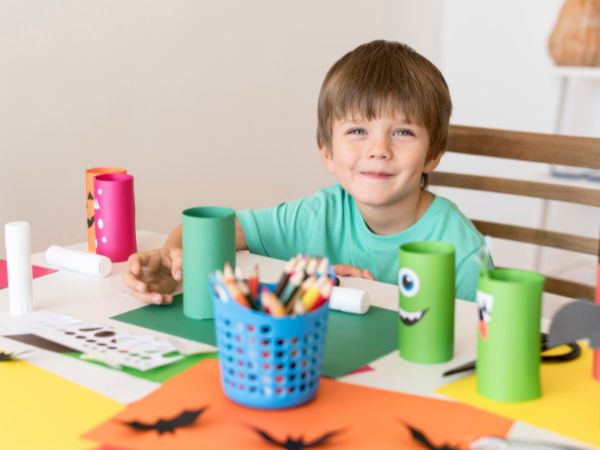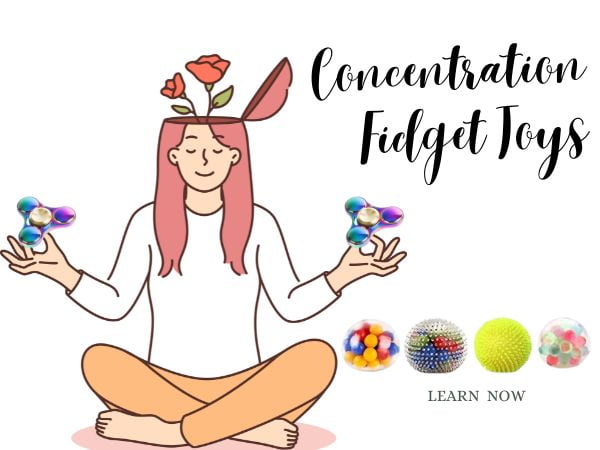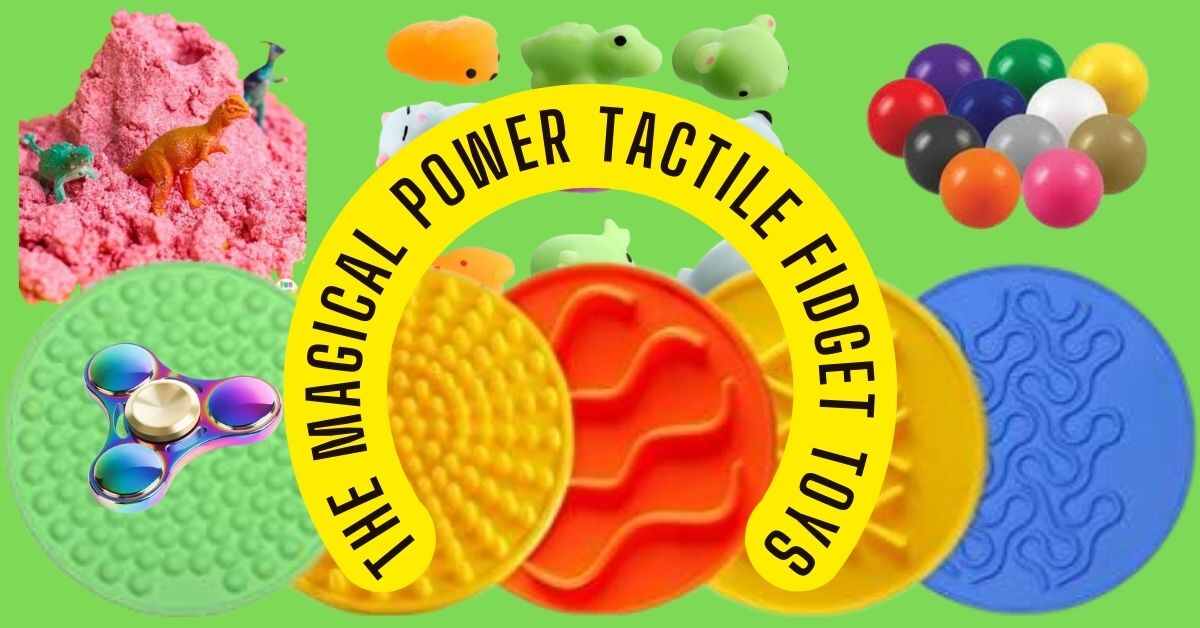I. Introduction
With their ability to handle everyday issues, occupational therapy fidget toys have emerged as an important tool in therapy, improving the well-being of persons. These playthings encourage concentration, engagement, and general sensory health.

Table of Contents
Fidget toys have become essential instruments in occupational therapy, critical in resolving these issues. This investigation will go into the specifics of occupational therapy fidget toys, including their definition, how they differ from ordinary toys, and how important they are in therapeutic environments.
II. Understanding Occupational Therapy Fidget Toys
A. Differentiating between regular and occupational therapy fidget toys
| Aspect | Regular Fidget Toys | Occupational Therapy Fidget Toys |
| Design Philosophy | Primarily for general entertainment and distraction | Purposefully crafted for therapeutic interventions |
| Tailored Design | Often generic, one-size-fits-all designs | Customized to address specific sensory needs |
| Therapeutic Intent | Not explicitly designed with therapeutic goals | Designed with a focus on therapeutic benefits |
| Sensory Engagement | May provide sensory stimulation but not targeted | Offers targeted sensory engagement for therapy |
| Personalization | Limited options for individualized preferences | Tailored to individual preferences and therapy goals |
| Empathetic Connection | Often lacks a connection to therapeutic principles | Inherently aligned with sensory processing theories |
| Use in Therapy Programs | Not commonly integrated into therapeutic programs | Actively incorporated into occupational therapy plans |
| Versatility | Widely available with varied purposes | Specifically designed for therapeutic versatility |
| Focused Therapeutic Outcomes | May not explicitly target specific therapeutic goals | Aligned with therapeutic objectives and outcomes |
| Material Quality | Quality varies widely | Crafted with attention to quality for therapeutic use |
B. Importance of fidget toys in therapeutic settings
In the hands of occupational therapists, fidget toys play an unsung hero role by promoting focus, self-regulation, and sensory engagement in therapeutic settings. They have an extraordinary power.
1. A Symphony of Focus: Fidget toys and fingers work together to produce a focusing symphony that directs restless energy into intentional movement.
2. Harnessing Self-Regulation: Occupational Therapy Fidget toys facilitate tactile communication between users and the toy, which helps with self-regulation and promotes self-awareness and sensory modulation.
3. Invoking Sensory Engagement: Occupational therapists employ sensory toys, such as liquid motion bubblers and textured stress balls, to reawaken dormant senses, enabling people to reacquaint themselves with their environment.
4. Nurturing Emotional Resilience: When utilized by occupational therapists, fidget toys help people develop emotional resilience by giving them a way to manage stress and anxiety and by acting as a heartbeat metaphor.
5. Bridges to Communication: For people who have trouble expressing themselves verbally, fidget toys act as a bridge to enable deeper connections and nonverbal communication between therapists and those in need of comfort.
6. Tailoring Therapeutic Interventions: Using fidget toys to address sensory needs and therapeutic goals, occupational therapists carefully customize therapies to meet the specific needs of each patient.
III. The Science Behind Fidget Toys
A. Cognitive Benefits: “Boosting Brain Power: The Science Behind Fidget Toy Therapy”
Occupational Therapy Fidget Toys are not just toys, but they are also tools that promote focus, self-regulation, and sensory engagement. These toys are designed to stimulate the brain through sensory information, triggering a cascade of cognitive responses. They act as anchors in the tumultuous sea of distractions, redirecting excess energy into purposeful movement. The tactile and kinaesthetic features of these toys create a calming rhythm, guiding the mind toward a serene center.
The act of fidgeting, whether it’s squeezing a stress ball or twirling a tangle toy, becomes a form of emotional release, helping individuals navigate stress and anxiety, and forging a pathway towards emotional well-being.
Occupational therapists integrate these fidget toys into therapeutic interventions, selecting specific toys tailored to individual needs.
B. Examining the neurological impact of fidgeting
Fidgeting has a profound neurological impact on the brain, acting as a choreography of neural engagement. The subtle movements of fidget toys stimulate the brain’s neural network, awakening dormant pathways and creating a canvas of connectivity.
Fidgeting also taps into kinaesthetic learning, enhancing memory and comprehension through physical movements. It also resonates with the emotional centers of the brain, reducing stress and anxiety.
Consistent engagement with fidget toys fosters adaptive changes in neural pathways, promoting resilience and enhancing the brain’s capacity to navigate challenges.
IV. Types of Occupational Therapy Fidget Toys
Occupational therapy fidget toys are designed to provide sensory input and promote focus, attention, and relaxation. Here are the types of occupational therapy fidget toys based on different sensory modalities:
A. Tactile Fidgets:

- Textured Stress Balls: These are soft, squeezable balls with different textures, such as raised bumps or ridges. They provide tactile input and can help individuals relieve stress and improve hand strength.
- Fidget Cubes: These small, handheld cubes have various tactile features on each side, including buttons, switches, and textures. Users can manipulate different sides to engage their sense of touch.
- Tangle Toys: Tangle toys consist of interconnected, twistable pieces that come in various textures. They are flexible and can be twisted and turned, offering a tactile and kinaesthetic outlet.
- Squishy Toys: These toys are made of soft, pliable materials that can be squished and squeezed. They are particularly effective for individuals who seek tactile stimulation to help with concentration.
B. Visual Fidgets:
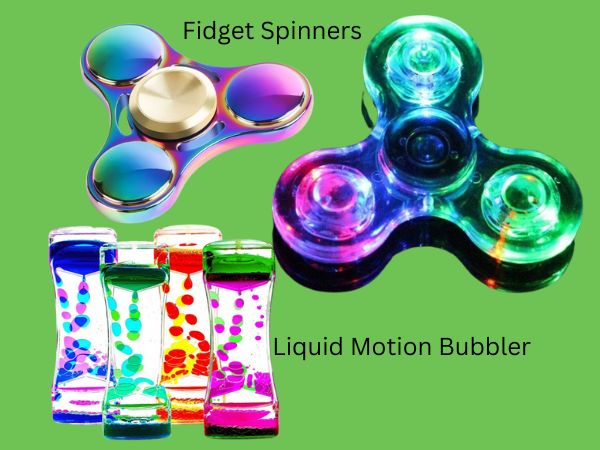
- Liquid Motion Bubbler: This toy contains colorful liquid that flows slowly, creating visually captivating patterns. Watching the liquid movement can have a calming effect and promote visual focus.
- Fidget Spinners: These handheld devices have a central ball bearing that allows them to spin. The spinning motion, along with visually interesting designs, provides a focal point that can help individuals concentrate.
- Light-Up Fidget Toys: These toys incorporate LED lights that change colors. The visual stimulation from the changing lights can be engaging and may assist individuals in maintaining attention.
C. Auditory Fidgets:
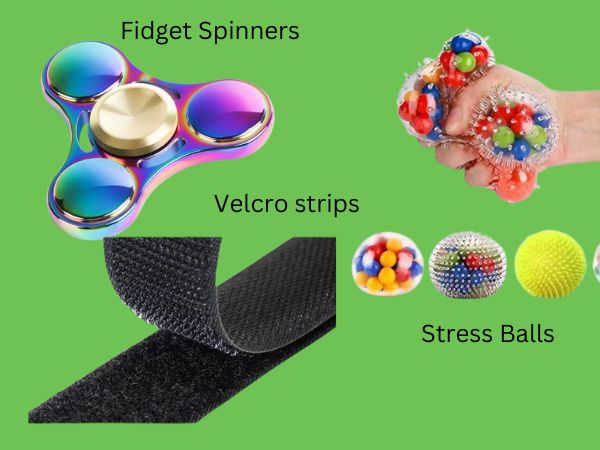
- Fidget Spinners with Bearings: Fidget spinners equipped with noiseless bearings allow individuals to fidget without creating distracting sounds, making them suitable for quiet environments.
- Noiseless Stress Balls: Squeeze balls designed to produce minimal noise are ideal for discreet fidgeting without causing disturbances in the surrounding environment.
- Quiet Fidget Tools: Tools like Velcro strips or fabric patches can be manipulated quietly, offering a tactile and auditory sensory experience without being disruptive.
D. Kinaesthetic Fidgets:

- Resistance Bands: Stretchable bands provide resistance and can be used for stretching or fidgeting, promoting movement and muscle engagement.
- Fidget Mats: Mats with different textures and attachments allow individuals to explore and engage their hands in various activities while sitting, promoting subtle movements.
- Body Movement Tools: Items like stability cushions or wobble cushions encourage subtle body movements, providing sensory input and improving focus.
Choosing the right type of fidget toy depends on an individual’s sensory preferences and therapeutic goals. Occupational therapists often tailor their recommendations based on the unique needs of each person.
V. Benefits for Different Age Groups
Occupational therapy fidget toys offer various benefits across different age groups. Here are the benefits for different age groups:
1. Children (Preschool to Elementary School):
- Enhanced Concentration: Fidget toys can help children concentrate better in the classroom by providing a sensory outlet, allowing them to focus on tasks.
- Fine Motor Skill Development: Manipulating fidget toys can contribute to the development of fine motor skills and hand-eye coordination in younger children.
- Stress Reduction: Fidget toys can act as stress relievers, helping children manage anxiety or excess energy.
2. Adolescents (Middle to High School):
- Improved Focus: Fidget toys can be beneficial for teens with attention difficulties, allowing them to channel excess energy and improve concentration during academic tasks.
- Stress and Anxiety Management: Adolescents often face increased stress. Fidget toys can serve as a discreet tool for managing anxiety and stress levels, particularly during exams or challenging situations.
- Increased Productivity: Some teens find that using fidget toys can enhance their productivity by providing a healthy outlet for restless energy.
3. Adults (Young Adults to Seniors):
- Stress Relief: Fidget toys are not limited to specific age groups and can help adults manage stress in various settings, such as the workplace or during daily activities.
- Cognitive Benefits: For seniors, fidget toys may support cognitive function by providing mental stimulation and engagement.
- Enhanced Focus in Meetings or Work: Adults in professional settings can discreetly use fidget toys to maintain focus during meetings or when working on tasks, potentially increasing productivity.
4. Individuals with Special Needs or Disabilities:
- Sensory Integration: Occupational therapy fidget toys are often used as tools for sensory integration in individuals with autism, ADHD, or other developmental disorders.
- Calming Effects: Fidget toys can have a calming effect on individuals with sensory processing challenges, assisting in self-regulation.
VI. Case Studies and Success Stories
A. Real-Life Transformations: Occupational Therapy Fidget Toy Success Stories
These stories highlight diverse individuals facing various challenges who find success through this intervention.
1. Alex’s Focus Journey:
Struggle: Alex, a 10-year-old with ADHD, found it challenging to concentrate in school.
Triumph: Through occupational therapy, Alex incorporated fidget toys into daily routines. Simple tools like stress balls and textured bands provided sensory input, helping Alex channel excess energy. Over time, his focus improved, leading to enhanced academic achievements and increased self-confidence.
2. Emily’s Anxiety Relief:
Struggle: Emily, a 30-year-old office worker, struggled with anxiety during high-stress periods at work. This affected her productivity and overall well-being.
Triumph: Occupational therapy introduced Emily to discreet fidget tools like spinners and textured cubes. These toys became outlets for nervous energy, helping her manage anxiety in real time. As a result, Emily experienced improved work performance, reduced stress levels, and a more positive work environment.
3. Carlos’ Sensory Integration Success:
Struggle: Carlos, a 7-year-old on the autism spectrum, faced challenges in sensory integration, impacting his ability to participate in daily activities and socialize with peers.
Triumph: Occupational therapy incorporated a variety of fidget toys tailored to Carlos’ sensory needs. Tactile discs, chewable jewelry, and weighted blankets became integral parts of his routine. As a result, Carlos experienced improved sensory regulation, leading to increased engagement in activities and enhanced social interactions with classmates.
4. Sophie’s Fine Motor Breakthrough:
Struggle: Sophie, a 45-year-old stroke survivor, faced difficulties in regaining fine motor skills in her dominant hand, hindering her ability to perform daily tasks.
Triumph: Occupational therapy introduced Sophie to fidget toys that targeted fine motor skills. Squeezable balls and textured grips provided therapeutic exercises, aiding in hand strength and coordination. Over time, Sophie regained significant functionality in her hand, allowing her to regain independence in daily activities.
B. Measurable Outcomes: Demonstrating improvements in focus, attention, and overall well-being
The effectiveness of fidget toys in occupational therapy is often supported by measurable outcomes, with improvements observed in focus, attention, and overall well-being. Here are some key metrics and evidence-based findings:
1. Improved Attention Span:
- Objective Measurement: Conducting pre- and post-intervention attention tests, such as sustained attention tasks or continuous performance tasks, provides quantifiable data.
- Evidence: Studies have shown that individuals using fidget tools during cognitive tasks exhibit increased attention span. Maintaining focus over extended periods improves, as evidenced by enhanced task completion rates and reduced errors.
2. Enhanced Academic Performance:
- Objective Measurement: Analysing academic performance metrics, such as grades, completion of assignments, and participation levels, provides concrete evidence of progress.
- Evidence: Research involving students using fidget toys during learning activities has shown a positive correlation with improved academic performance. This is often attributed to increased engagement and reduced distraction, leading to better information retention and comprehension.
3. Stress Reduction:
- Objective Measurement: Employing standardized stress assessment tools, such as self-report scales or physiological measurements (heart rate variability, cortisol levels), allows for the quantification of stress reduction.
- Evidence: Numerous studies indicate that fidget toys contribute to stress reduction. Individuals who regularly use these tools report lower stress levels, improved mood, and better overall emotional well-being.
4. Behavioral Changes:
- Objective Measurement: Utilizing behavioral observation scales or checklists to document changes in disruptive behaviors, impulsivity, or restlessness.
- Evidence: Occupational therapy interventions involving fidget toys have demonstrated positive behavioral changes. Reduced fidgeting, improved self-regulation, and increased on-task behavior are commonly observed outcomes, contributing to a more positive environment.
5. Sensory Regulation:
- Objective Measurement: Employing sensory assessment tools to measure changes in sensory processing, such as the Sensory Profile or Sensory Integration and Praxis Tests.
- Evidence: Fidget toys designed for sensory stimulation have been shown to enhance sensory regulation. Individuals with sensory processing challenges exhibit improved sensory modulation, leading to increased comfort and participation in daily activities.
6. Quality of Life Assessments:
- Objective Measurement: Using standardized assessments of quality of life, such as the World Health Organization Quality of Life (WHOQOL) questionnaire.
- Evidence: Occupational therapy interventions incorporating fidget toys contribute to improvements in overall well-being. Individuals report enhanced satisfaction with daily activities, improved social interactions, and increased participation in meaningful occupations.
VII. Integrating Fidget Toys into Daily Life
A. Workplace: “Focus at Work: Incorporating Fidget Toys into Professional Settings”
Fidget toys can seamlessly integrate into professional settings, providing a discreet and effective means to enhance focus and productivity in the workplace. Here’s how:
1. Discreet Desk Accessories:
- Integration: Fidget spinners, stress balls, or textured cubes can be discreetly placed on a desk. They serve as unobtrusive tools that employees can use during meetings, phone calls, or while working on tasks.
- Effect on Focus: Employees can discreetly engage with these fidget toys, promoting a subtle outlet for excess energy. This helps to maintain focus during tasks that require sustained attention, contributing to increased productivity.
2. Calming Sensory Tools:
- Integration: Weighted lap pads, soft fidget pads, or stress-relief gadgets can be integrated into office seating or workstations.
- Effect on Stress Reduction: Calming sensory tools provide tactile stimulation, promoting relaxation and stress reduction. In high-pressure situations, employees can use these tools to manage stress and maintain composure, fostering a more positive work environment.
3. Incorporating Movement:
- Integration: Active seating options, such as stability balls or wobble cushions, can replace traditional office chairs.
- Effect on Energy Levels: Incorporating movement into the workday helps prevent sedentary behavior. Employees can engage in subtle movements, improving circulation and energy levels, which positively impact focus and productivity.
4. Sensory Break Spaces:
- Integration: Designating a sensory break area with various fidget tools allows employees to take short breaks when needed.
- Effect on Rejuvenation: Short breaks with sensory engagement help refresh the mind. Employees can return to their tasks with renewed focus and energy, enhancing overall productivity.
5. Customizable Workstations:
- Integration: Offering employees, the flexibility to personalize their workspaces with fidget tools of their choice.
- Effect on Personalized Comfort: Allowing employees to choose their preferred fidget tools creates a personalized and comfortable work environment. This sense of autonomy can positively impact job satisfaction and focus.
6. Mindfulness and Focus Training:
- Integration: Introducing mindfulness exercises and focus training as part of workplace wellness programs.
- Effect on Cognitive Performance: Mindfulness practices, combined with fidget tools, contribute to improved concentration and cognitive performance. This integration supports employees in managing stress and maintaining focus throughout the workday.
B. Educational Settings: “Smart Play: Fidget Toys in Schools and Learning Environments”
Fidget toys play a valuable role in the educational realm, contributing to smart play in schools and learning environments. Their incorporation can enhance engagement and concentration among students in various ways:
1. Tactile Stimulation for Focus:
- Role in Smart Play: Fidget toys with tactile features, such as textured surfaces, squeeze balls, or putty, provide sensory stimulation.
- Promoting Engagement: Students can discreetly engage with these toys during lessons, promoting focused attention. The tactile input helps channel excess energy, allowing students to concentrate on learning tasks.
2. Quiet and Discreet Distraction Management:
- Role in Smart Play: Fidget spinners, stress balls, or small fidget cubes offer quiet and discreet ways to manage distractions.
- Promoting Concentration: In a classroom setting, students can use these toys without causing disruption. This helps manage restlessness or fidgeting tendencies, allowing students to concentrate on lessons without disturbing peers.
3. Active Seating Options:
- Role in Smart Play: Stability balls or wiggle cushions provide an active seating alternative in classrooms.
- Promoting Engagement: Active seating encourages subtle movements, preventing sedentary behavior. This dynamic approach to sitting can enhance blood flow and engagement, promoting better concentration during lessons.
4. Cognitive Skill Development:
- Role in Smart Play: Educational fidget toys designed to stimulate cognitive skills, such as puzzle fidgets or manipulative gadgets.
- Promoting Learning: These toys engage students’ minds while providing a physical outlet for movement. As students manipulate the toys, they enhance fine motor skills, problem-solving abilities, and cognitive flexibility, contributing to a more enriched learning experience.
5. Sensory Breaks for Regulation:
- Role in Smart Play: Designated sensory break areas with a variety of fidget tools.
- Promoting Concentration: Students can take short sensory breaks when needed. These breaks, with access to fidget toys, help regulate sensory input and promote better focus when returning to classroom activities.
6. Personalized Learning Environments:
- Role in Smart Play: Allowing students to choose fidget tools that suit their preferences.
- Promoting Engagement: Personalization creates a sense of autonomy. When students have the ability to choose their preferred fidget tools, they are more likely to use them actively, contributing to increased engagement and concentration.
7. Mindfulness and Calming Practices:
- Role in Smart Play: Integrating mindfulness exercises with fidget toys.
- Promoting Concentration: Mindfulness practices, combined with fidget tools, help students develop self-awareness and emotional regulation. This, in turn, contributes to improved concentration and a positive learning environment.
C. Home and Leisure: “Relax and Revitalize: Using Fidget Toys in Daily Life”
Fidget toys can seamlessly become a part of daily life at home and leisure activities, offering relaxation and revitalization for individuals of all ages. Here’s how they can be incorporated:
1. Relaxation Zones at Home:
- Incorporation: Designate specific areas at home as relaxation zones and equip them with a variety of fidget tools like stress balls, sensory pillows, or textured mats.
- Benefits: These designated spaces allow individuals to unwind and de-stress, promoting relaxation and revitalization after a busy day.
2. Family Game Nights with Fidget Toys:
- Incorporation: Introduce fidget toys with game-like features during family game nights. Examples include fidget spinners incorporated into board games or puzzle fidgets for collaborative play.
- Benefits: Fidget toys can add an element of fun and relaxation to family activities, fostering positive interactions and creating a shared sense of enjoyment.
3. Sensory Gardens and Outdoor Spaces:
- Incorporation: Create sensory gardens or outdoor spaces with elements like wind chimes, textured plants, and kinetic sculptures.
- Benefits: These spaces provide a natural and calming environment for individuals of all ages to engage with sensory experiences, promoting relaxation and revitalization through connection with nature.
4. Mindful Practices with Fidget Tools:
- Incorporation: Integrate mindfulness practices, such as meditation or deep breathing exercises, with fidget tools like stress balls or textured gadgets.
- Benefits: The combination of mindfulness and fidget tools helps individuals focus their minds, reduce stress, and enhance overall well-being.
5. Art and Creativity with Fidget Toys:
- Incorporation: Include fidget toys in creative pursuits like drawing, painting, or crafting.
- Benefits: Engaging in artistic activities with fidget tools allows for self-expression and relaxation, serving as a therapeutic outlet for individuals of all ages.
6. Reading and Fidget Tools:
- Incorporation: Pair reading sessions with fidget toys, such as textured bookmarks or silent fidget gadgets.
- Benefits: The tactile engagement with fidget tools while reading can enhance the reading experience, providing a calming and enjoyable leisure activity.
7. Digital Detox with Fidgets:
- Incorporation: Encourage digital detox times where individuals put away electronic devices and engage with tactile fidget toys.
- Benefits: Disconnecting from screens and engaging with fidget tools promotes mindfulness, reduces stress, and allows individuals to recharge mentally.
8. Fitness and Fidgets:
- Incorporation: Incorporate fidget toys into fitness routines, such as stress balls during stretching or using textured mats for yoga.
- Benefits: The combination of physical activity and fidget tools enhances the overall experience, promoting relaxation and revitalization for both the body and mind.
VIII. Potential Challenges and Solutions
A. Overuse Concerns: “Balancing Act: Addressing Concerns of Overusing Fidget Toys”
Improved focus, lowered stress levels, and better sensory modulation are just a few of the therapeutic advantages of fidget toys. On the other hand, excessive use can have negative social effects, reliance, and distraction.
A tailored strategy, including evaluation and direction from occupational therapists, is required to address these concerns. Policies should be put in place in the workplace and in schools, and guidelines for the usage of fidget toys should be established.
Occupational therapists do routine evaluations to make sure the usage of fidget toys is in line with therapeutic objectives. Alongside fidget toys, alternatives like mindfulness exercises and quick breaks should be encouraged.
B. Social Stigma: “Breaking the Stigma: Fidget Toys and Social Acceptance”
It is imperative to tackle the societal stigma associated with fidget toys to foster acceptance and understanding.
It’s important to educate people about the benefits and uses of fidget toys, which are therapeutic tools that help people reduce stress, sharpen their focus, and control their senses.
Open communication and the sharing of success stories can help change the perception of fidget toys from one of stigma to one of the benefits for mental health and wellbeing.
IX. Tips for Caregivers and Educators
Here are practical tips tailored for parents, teachers, and caregivers to empower them in supporting individuals using fidget toys:

1. For Parents:
- Maintain open communication with your child about their experience with fidget toys,
- Collaborate with teachers to ensure consistent use,
- Create a quiet, fidget-friendly homework space,
- Encourage independence by teaching your child to advocate for their needs, and
- Experiment with different fidget options to find what resonates best for your child.
This approach ensures a supportive learning environment and helps them express their preferences.
2. For Teachers:
- Include information regarding the use of fidget toys in the curriculum to include them in students’ IEPs.
- Create fidget-friendly areas in the classroom,
- Inform classmates about their advantages, offer a range of choices, and
This lessens potential stigma and encourages inclusivity.
3. For Caregivers:
- In order to use fidget toys effectively, one must incorporate them into everyday routines,
- Set an example of positive attitudes, offer a range of sensory experiences, promote self-expression, and
- Keep up with current research and best practices.
This will promote autonomy and self-advocacy skills in people, mainstream their use, and establish a supportive environment.
X. The Future of Fidget Toy Therapy
The future of fidget toy therapy holds exciting possibilities, driven by advancements in technology, an increased understanding of sensory needs, and a growing recognition of the benefits these tools offer. Here are some potential directions for the future of fidget toy therapy:
1. Innovations in Sensory Technology: Smart fidget toys with sensors could provide real-time data on individual responses, allowing for more personalized and effective therapeutic interventions.
2. Customization and Personalization: Advances in manufacturing techniques, such as 3D printing, may enable the creation of highly individualized fidget tools, that address specific sensory preferences and needs.
3. Digital and Augmented Reality Integration: Development of digital and augmented reality-based fidget tools.
4. Biofeedback-Enhanced Fidget Tools: Real-time biofeedback, such as heart rate monitoring, could provide valuable insights into an individual’s stress levels, enhancing the effectiveness of fidget tools for relaxation and self-regulation
5. Wearable Fidget Technology: Wearable devices with integrated fidget tools could offer continuous sensory support throughout the day, discreetly adapting to various environments.
6. Smart Analytics for Therapists: Data analytics could inform therapists about the long-term effectiveness of fidget toys, enabling evidence-based adjustments to therapeutic plans.
XI. User Reviews and Recommendations
For the latest and most personalized reviews, explore online platforms, forums, and community discussions. Let’s see some user reviews:
- User Review 1: “Fidget toys have been a game-changer for me in managing stress. The tactile sensations provide a soothing experience, and it’s become an essential part of my daily routine.”
- User Review 2: “As a student with ADHD, fidget toys have really helped me stay focused during lectures. Having something to fidget with allows me to channel excess energy and concentrate better on the material.”
- User Review 3: “For my child with autism, fidget toys have been a blessing. They help regulate sensory input and provide a calming effect in overwhelming situations. A must-have for parents in similar situations.”
- User Review 4: “Working in a corporate environment, I needed a discreet solution for managing stress. Fidget toys have been perfect for that – quiet, unobtrusive, and effective. Colleagues have even asked for recommendations!”
- User Review 5: “In my classroom, I introduced fidget toys, and the results were fantastic. Students who struggled with attention issues became more engaged in lessons. It’s a simple yet powerful tool for educators.”
These reviews highlight the positive impact of fidget toys across various aspects of life, from stress reduction to educational support and sensory regulation.
XII. FAQs (Frequently Asked Questions)
1. What are occupational therapy fidget toys?
Ans: Occupational therapy fidget toys are tools designed to provide sensory input and promote focus, attention, and relaxation.
2. How do occupational therapy fidget toys work?
Ans: Fidget toys work by engaging one or more sensory modalities, such as touch, sight, sound, or movement.
3. Who can benefit from using occupational therapy fidget toys?
Ans: Individuals with sensory processing difficulties, attention disorders, anxiety, or other conditions that affect focus and concentration can benefit from using fidget toys.
4. Do fidget toys help with attention?
Ans: Yes, fidget toys are often used to help improve attention in individuals with attention-related challenges.
5. Can fidget toys be used in educational settings?
Ans: Yes, fidget toys are increasingly being used in educational settings to help students focus and manage sensory challenges.
6. How do I choose the right fidget toy for an individual?
Ans: The choice of a fidget toy depends on the individual’s sensory preferences and therapeutic goals.
7. Are fidget toys a distraction or a helpful tool?
Ans: When used appropriately and in line with individual needs, fidget toys can be helpful tools.
8. Can fidget toys replace other forms of therapy?
Ans: Fidget toys are often used as adjuncts to other therapeutic interventions. While they can be beneficial in managing certain aspects of sensory challenges, they are not intended to replace comprehensive therapy programs.
9. Are there any safety considerations when using fidget toys?
Ans: It’s essential to choose fidget toys that are age-appropriate and safe for use. Small parts that could be a choking hazard should be avoided, and individuals with specific health conditions or sensitivities should consult with their healthcare or occupational therapy professionals before using certain types of fidget toys.
10. Where can I purchase occupational therapy fidget toys?
Ans: Fidget toys are available at various retailers, both online and offline.
XIII. Conclusion
In conclusion, the journey through the world of occupational therapy fidget toys reveals a tapestry woven with significance and transformative potential. These tools, designed with purpose and precision, have emerged as valuable allies in enhancing sensory experiences and promoting well-being across diverse age groups.
Disclaimer:
Users are encouraged to seek the latest information from reputable sources, including research publications, industry experts, and relevant professionals. Any decisions or actions taken based on the information provided are the sole responsibility of the individual.
Furthermore, this content does not replace personalized advice from qualified healthcare professionals, therapists, or experts in the field. Individuals with specific sensory needs or related concerns are advised to consult with appropriate professionals for tailored guidance and recommendations.

